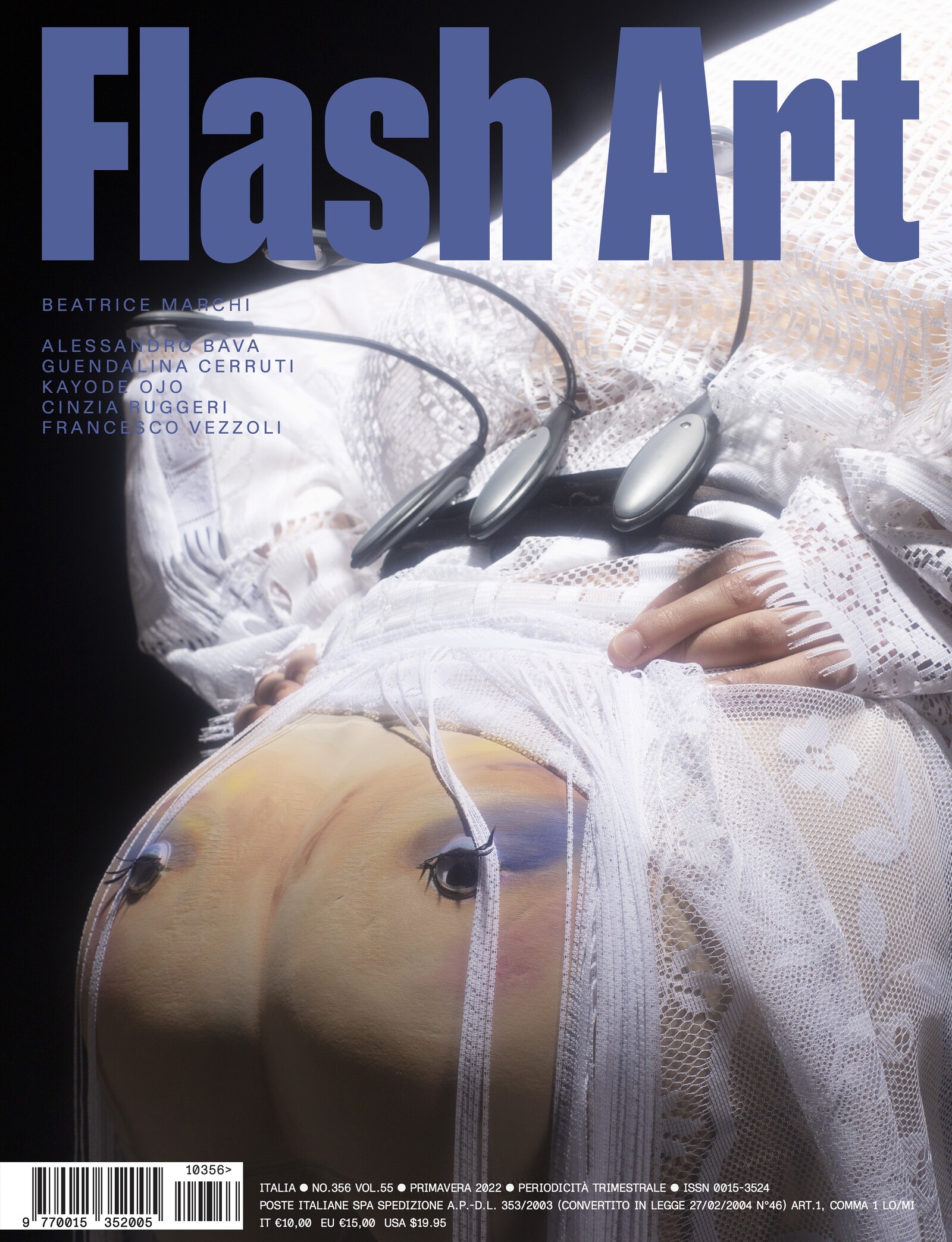This issue of Flash Art’s Italian edition surveys a cross section of our artistic and visual present that plays with the history of art, giving it an irreverent, caricatural dimension, particularly through productions that reflect the fragility of the individual in relation to society. Susy Culinski, one of Beatrice Marchi’s alter egos, is the protagonist of the cover: two fake eyes with fake eyelashes, inexpressive, placed on a butt facing the viewer. What do they observe? Marchi uses Culinski and other identities to problematize human relationships and social interactions, manipulated and acted out through the filter of the screen. In various guises, her characters come to life via a transmedia narrative that enacts a “desire to pathologize the other in an attempt to externalize self-loathing,” as Steven Warwick notes.
This issue is populated by many beings with uncertain identities, such as Guendalina Cerruti’s sculpture-dogs which, as Vincenzo Di Rosa notes, “seem to be trapped in a different world even if they maintain a strange link with ours.” The ways in which Cerruti manipulates ordinary objects, reifying a homologating aesthetic, somewhat recalls the process of decomposition and reconstruction in Kayode Ojo’s sculptures. The latter, inspired by models of commercial presentation such as shop windows, exploit the rhetoric of exposure and activate a dynamic of desire and deception typical of the mechanism of sales. As Blake Oetting writes, Ojo’s works “also act as projective screens for the viewer’s interest in particular items, ideologies, and modes of looking.”
Modes of looking at the spaces we inhabit might describe Alessandro Bava’s research in these pages this year. In the three previous episodes of his column “SPAZIO,” Bava has cited research that goes beyond disciplinary boundaries. In a moment when we are called to question physical and spatial experience as a vehicle of knowledge, in a world increasingly shaped by digital technologies, he identifies space as an intrinsically emotional and narrative medium. For this last episode, he decided to submit his own research to his exercise by inviting Octave Perrault to observe his architectural and curatorial practice, activating a gaze upon the gaze. We’ve tried to do something similar by rereading a kaleidoscopic figure such as Cinzia Ruggeri through the eyes and the pen of two living artists, Anna-Sophie Berger and Anna Franceschini, from different generations and backgrounds but with a common fascination for the object.
Also in this issue: Carlo Antonelli, in conversation with Francesco Vezzoli, reconsiders the origins of the Brecsian artist’s work, defining it as a biopolitical manifestation of all the suffering and nostalgia that today is translated into a vanished American dream, during a present that he now lives with a natural detachment; a present, too, that Cecilia Alemani thinks of in relation to Leonora Carrington’s book The Milk of Dreams—also the title of the 59th Venice Biennale—which she defines as “surprising and cold.”
In addition, the second episode of the column “CROSS/ROADS,” curated by Ilaria Gianni and Eleonora Milani with the collaboration of Giulia Gelmini, analyzes the art scene orbiting around Milan. This episode looks at Lombardy as a system of geo-social and geo-cultural complexities, in particular at the three “satellite” cities Bergamo, Brescia, and Como—strongly connected to and in some ways dependent on their metropolitan center of gravity, yet revealing their own vital and by no means passive art scenes.
Reviews: Role play, Osservatorio Fondazione Prada, Milan / Jasmine Gregory, Mommie dearest, Istituto Svizzero, Milan / Nina Canell, HARDSCAPES, OGR, Turin / SPAZIO RADICALE / RADICAL SPACE, Centro Pecci, Prato / Cao Fei, Supernova, MAXXI, Rome / Rethinking Nature, Museo Madre, Naples / Le 3 ecologie, MACTE, Termoli / Charlotte Posenenske, FROM B TO E AND MORE, Fondazione Antonio Dalle Nogare, Bolzano.
The issue will be available at miart, Milan; Arte Fiera, Bologna; and the 59th International Art Exhibition - La Biennale di Venezia.


